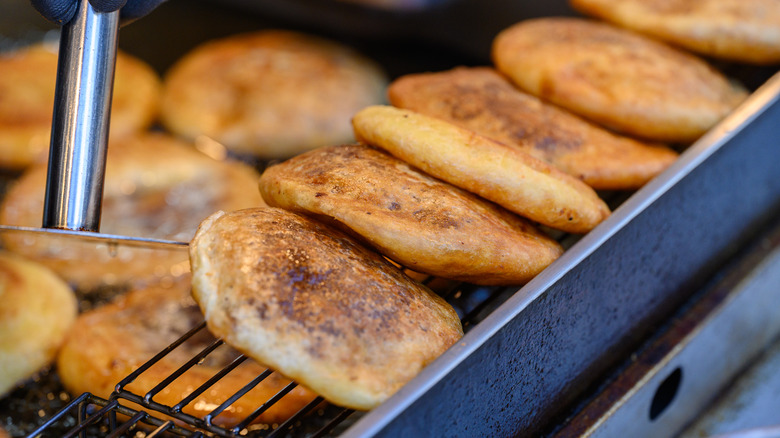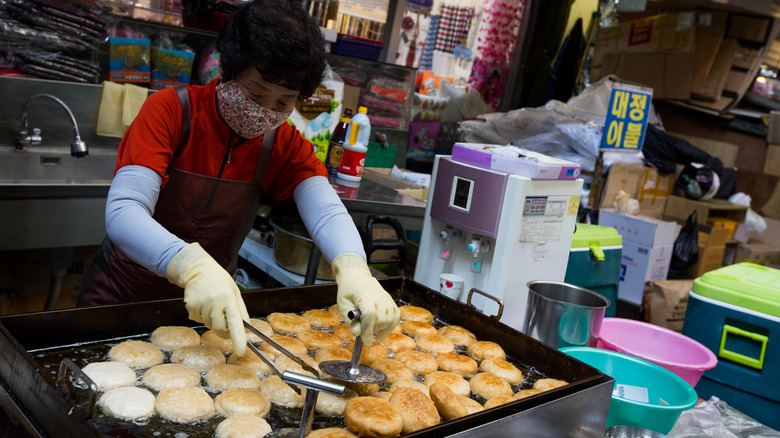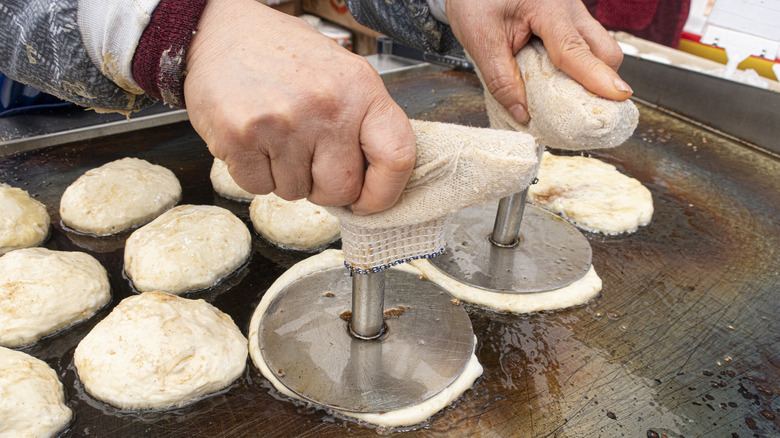Hotteok Is The Korean Pancake Stuffed With Sweet Flavors
While the glitz and glamor of fine dining often gets the attention in the culinary world, some of the greatest bites from around the globe are found as street food. From Thai satay and peanut sauce to Mexican tacos to Colombian arepas, culinary creations born from small stalls have become internationally popular and even reinterpreted into more upscale settings. Now, a sweet Korean treat — a pancake-like creation called hotteok — is receiving the limelight.
Made with a simple flour and yeast dough, the appeal of the beloved street snack is immediate. Crispy on the outside with a chewy, almost gooey interior, a bite hits the right notes — and all such goodness is contained in a paper bag that makes it easily enjoyed on the move. Though the insides of this dough pocket are traditionally filled with sugar and nuts for added crunch, a wave of chefs is now reinterpreting the pastry in new directions, using everything from Nutella to salted caramel. The easy-to-love snack is gaining increasing prominence abroad, and a look at this relatively new Korean classic shows why hotteok is a treat worth a try.
Hotteok is a product of international influences
While hotteok is largely considered a Korean treat, it arrived in the country by way of China, largely popularized at the end of the 19th century when Chinese soldiers were sent to Seoul to quell an uprising known as the Imo Incident. Many of these military men stayed in Korea and turned to selling the doughy creation — at first, typically featuring savory fillings rather than sweet — as street food. Over the subsequent decades, the pastry spread by way of merchants, who popularized the snack around the country.
Originally, the doughy creation was cooked in a small furnace. However, after the Korean War, the arrival of inexpensive sugar and wheat from the Americans — alongside the popularization of cooking in oil — turned the dish into a streetside classic. Varying regional renditions appeared, and the food gained esteem as a winter treat. Although the closing of many street food stalls for the 1988 Seoul Olympics lessened the food's prevalence, it thankfully didn't erase it — and you can continue to find hotteok as an affordable snack from street vendors around South Korea.
The fun is in the filling
Hotteok is a yeast-based pastry that comes together with only a few ingredients. It's based on all-purpose flour, which is mixed with salt, different sugars, and vegetable oil. The creation process is similar to other yeast-based recipes; the bacteria are activated with warm water, and the dough is leavened for a few hours. Once ready, the resulting dough is rolled into small balls, which are flattened and stuffed with filling before being fried.
Although there are slight differences in the dough's preparations, the fillings are hotteok's prominent distinguishing factor. For example, Busan is famous for its seed-stuffed hotteok, which is sold at noted establishments throughout the city. Meanwhile, Korea's subtropical Jeju island crafts a sour rendition with tangerines, which grow abundantly on the island. More classic combinations feature crushed peanuts and sugar. And Korean food's growing popularity — both in Korea and abroad — is creating interest in even more new, wild interpretations of the pastry. From kimchi to even pizza, there are few (if any) limits on what goes inside, meaning there's likely a version out there to suit almost any taste.


